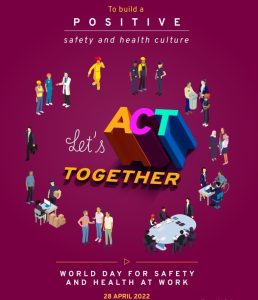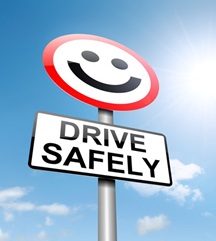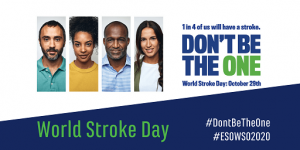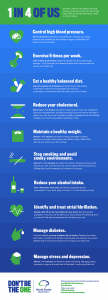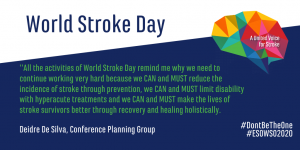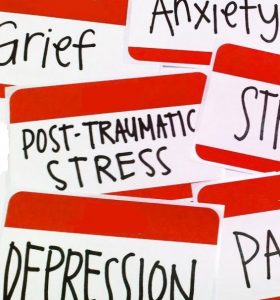
Mental health is among the most prevalent factors impacting the workplace. The overall health and safety of a workplace includes both the physical and psychological well-being of its workers. There is a link between mental health distress and increased safety risks – experiencing mental health distress can adversely affect risk recognition and actions of workers both off and on the job. By treating mental health and its psychological component equally with the physical environment, a workplace can support their workers’ overall well-being. Poor mental health not only hurts the individual, it also reduces corporate profits. It is important that all levels of the workplace get involved to incorporate mental health at your workplace.
Key risk factors for mental health problems in the workplace

Key risk factors for mental health problems in the workplace include:
- Workload (both excessive and insufficient work)
- Lack of participation and control in the workplace
- Monotonous or unpleasant tasks
- Role ambiguity or conflict
- Lack of recognition at work
- Inequity
- Poor interpersonal relationships
- Poor working conditions
- Poor leadership and communication
- Conflicts between work and family life – these should complement each other.
- Uncomfortable physical working conditions (extreme temperatures, poor ergonomy)
- Practices, poor scheduling, infrequent breaks
- Presenteeism – action of employees coming to work despite having a sickness that justifies an absence, therefore they are performing their work under sub-optimal conditions.
- Harassment, Violence, Bullying and Mobbing – Most people think of violence as a physical assault. However, workplace violence is a much broader problem. It is any act in which a person is abused, threatened, intimidated or assaulted in his or her employment.
- Fatigue at work (caused by long-term or chronic stress, poor working conditions, long working hours, poor sleeping patterns, personal reasons from home, etc.
Effect of the above risk factors on employees’ mental health and performance in the workplace

- Employees who look exhausted because their sleep is impacted.
- Employees who are skipping meals and breaks.
- Employees taking work home, returning emails after 11 PM or when on vacation; or cancelling days off because they feel they are behind.
- A sudden increase in sick days among employees.
- Noticeable decreases in the quality or quantity of work product.
- An increase in complaints about an employee.
- Arguments between employees.
- Emotional outbursts.
- Threats towards co-workers.
- Incidents of violence.
- Substance Use, Misuse and Abuse at Work.
Hopefully, the problem can be caught at this level. Because what comes next is much more drastic, and, if you are an employer, it is troubling.
However, all hope is not lost. As workplace advocates and leaders, there are steps you can take to not only recognize these issues before they rear their heads, but that you can take to prevent them from even beginning.
Factors to be considered by Organizations in other to create a mentally healthy workplace:

Thirteen psychosocial risk (PSR) factors have been identified by researchers at Simon Fraser University based on extensive research and review of empirical data from national and international best practices. The factors were also determined based on existing and emerging Canadian case law and legislation.
- Psychological Support
A workplace where co-workers and supervisors are supportive of employees’ psychological and mental health concerns, and respond appropriately as needed. For some organizations, the most important aspect of psychological support may be to protect against traumatic stressors at work.
Employees that feel they have psychological support have greater job attachment, job commitment, job satisfaction, job involvement, positive work moods, desire to remain with the organization, organizational citizenship behaviours (behaviours of personal choice that benefit the organization) and job performance.
Employee perceptions of a lack of psychological support from their organization can lead to:
Increased absenteeism, withdrawal behaviours, conflict, strain – which can lead to fatigue, headaches, burnout and anxiety, loss of productivity, increased costs, greater risk of accidents, incidents and injuries.
- Organizational Culture
A workplace characterized by trust, honesty and fairness. Organizational culture, in general, are basic assumptions held by a particular group. These assumptions are a mix of values, beliefs, meanings and expectations that group members hold in common and that they use as cues to what is considered acceptable behaviour and how to solve problems.
Organizational trust is essential for any positive and productive social processes within any workplace. Trust is a predictor of cooperative behaviour, organizational citizenship behaviours (behaviours of personal choice that benefit the organization), organizational commitment, and employee loyalty. An organization that has a health-focused culture enhances employee well-being, job satisfaction and organizational commitment, which helps to retain and attract employees. A work culture with social support also enhances employee well-being by providing a positive environment for employees who may be experiencing psychological conditions such as depression and anxiety.
Culture sets the tone for an organization – a negative culture can undermine the effectiveness of the best programs, policies and services intended to support the workforce. An unhealthy culture creates more stress, which lowers employee well-being. A culture of profit at all costs and constant chaotic urgency can create an environment in which burnout is the norm.
- Clear Leadership & Expectations
A workplace where there is effective leadership and support that helps employees know what they need to do, how their work contributes to the organization and whether there are impending changes.
Effective leadership increases employee morale, resiliency and trust, and decreases employee frustration and conflict. Good leadership results in employees with higher job well-being, reduced sick leave, and reduced early retirements with disability pensions. A leader who demonstrates a commitment to maintaining his or her own physical and psychological health can influence the health of employees (sickness, presenteeism, absenteeism) as well as the health of the organization as a whole (vigour, vitality, productivity).
Leaders who are more instrumental in their approach (focusing on producing outcomes, with little attention paid to the big picture, the psychosocial dynamics within the organization, and the individual employees) are more likely to hear staff health complaints including general feelings of malaise, irritability and nervousness. Similarly, leaders who do not demonstrate visible concern for their own physical and psychological health set a negative example for their staff and can undermine the legitimacy of any organizational program, policy and/or service intended to support employees. Middle managers are at greater risk because they must be leaders and be led simultaneously. This role conflict can lead to feelings of powerlessness and stress.
- Civility and Respect
A workplace where employees are respectful and considerate in their interactions with one another, as well as with customers, clients and the public. Civility and respect are based on showing esteem, care and consideration for others, and acknowledging their dignity.
A civil and respectful workplace is related to greater job satisfaction, greater perceptions of fairness, a more positive attitude, improved morale, better teamwork, greater interest in personal development, engagement in problem resolution, enhanced supervisor-staff relationships, and reduction in sick leave and turnover. Organizations characterized by civility and respect create a positive atmosphere marked by high spirits and work satisfaction. This civility allows people to enjoy the environment, whether they are staff, clients or customers.
A workplace that lacks civility and respect can lead to emotional exhaustion amongst staff, greater conflicts, and job withdrawal. A work environment that is uncivil and disrespectful also exposes organizations to the threat of more grievances and legal risks.
One example of disrespectful behaviour is bullying. Exposure to workplace bullying is associated with psychological complaints, depression, burnout, anxiety, aggression, psychosomatic complaints and musculoskeletal health complaints. Bullying not only affects those directly involved, but also affects bystanders, as they too experience higher levels of stress. A number of provinces currently have legislation to address such behaviours.
- Psychological Competencies & Requirements
A workplace where there is a good fit between employees’ interpersonal and emotional competencies, their job skills and the position they hold. A good fit means that the employees possess the technical skills and knowledge for a particular position as well as the psychological skills and emotional intelligence (self-awareness, impulse control, persistence, self-motivation, empathy and social deftness) to do the job. Note that a subjective job fit (when employees feel they fit their job) can be more important than an objective job fit (when the employee is assessed and matched to the job).
A good job fit is associated with: fewer health complaints, lower levels of depression, greater self-esteem, more positive self-concept, enhanced performance, job satisfaction and employee retention.
When there is a poor job fit, employees can experience job strain, which can be expressed as emotional distress and provocation, excessive dwelling on thoughts, defensiveness, energy depletion and lower mood levels. Organizationally, job misfit is linked to fewer applicants in the recruitment and training process, lack of enjoyment and engagement, poor productivity, conflict, and greater voluntary turnover.
- Growth & Development
A workplace where employees receive encouragement and support in the development of their interpersonal, emotional and job skills. This type of workplace provides a range of internal and external opportunities for employees to build their repertoire of competencies. It helps employees with their current jobs as well as prepares them for possible future positions.
Employee development increases goal commitment, organizational commitment and job satisfaction. Employees feel that organizations care when the organization supports growth and development. Skill acquisition and career development directly enhance employee well-being. It is important to ensure that opportunities go beyond learning specific technical skills, and also include opportunities to learn personal and interpersonal skills that are critical to successfully caring for oneself and relating to others.
Employees who are not challenged by their work will grow bored, their well-being will suffer, and their performance will drop. When staff do not have opportunities to learn and improve their interpersonal and psychological skills, the result can be conflict, disengagement and distress.
- Recognition and Reward
A workplace where there is appropriate acknowledgement and appreciation of employees’ efforts in a fair and timely manner. This element includes appropriate and regular financial compensation as well as employee or team celebrations, recognition of years served, demonstrating/acting according to organizational values, and/or milestones reached.
Advantages of Recognition and reward: motivates employees, fuels the desire to excel, builds self-esteem, encourages employees to exceed expectations and enhances team success.
Employees receiving appropriate recognition and reward have more energy and enthusiasm, a greater sense of pride and participation in their work, and are more likely to treat colleagues and customers with courtesy, respect and understanding.
Lack of recognition and reward undermines employee confidence in their work and trust in the organization. Employees may feel demoralized or they may quit. An imbalance between effort and reward is a significant contributor to burnout and emotional distress leading to a range of psychological and physical disorders.
- Involvement and Influence
A workplace where employees are included in discussions about how their work is done and how important decisions are made. Opportunities for involvement can relate to an employee’s specific job, the activities of a team or department, or issues involving the organization as a whole.
When employees feel they have meaningful input into their work they are more likely to be engaged, to have higher morale, and to take pride in their organization. This feeling, in turn, increases the willingness to make extra effort when required. Job involvement is associated with increased psychological well-being, enhanced innovation, and organizational commitment.
If employees do not believe they have a voice in the affairs of the organization, they tend to feel a sense of indifference or helplessness. Job alienation or non-involvement is associated with cynicism and distress, greater turnover, and burnout.
- Workload Management
A workplace where tasks and responsibilities can be accomplished successfully within the time available. A large workload is often described by employees as being the biggest workplace stressor (i.e., having too much to do and not enough time to do it). It is not only the amount of work that makes a difference but also the extent to which employees have the resources (time, equipment, support) to do the work well.
Most employees willingly work hard and feel a good day’s work is fulfilling and rewarding. Workload management is important because there is a unique relationship between job demands, intellectual demands and job satisfaction. Job demands reduce job satisfaction, while intellectual demands or decision-making latitude, increase job satisfaction. Even when there are high demands, if employees also have high decision-making ability, they will be able to thrive. Having high decision-making latitude also allows for positive coping behaviours to be learned and experienced.
Any system subject to excess load without reprieve will break. This is as true for people as it is for equipment. Increased demands, without opportunities for control, result in physical, psychological and emotional fatigue, and increase stress and strain. Emotionally fatigued individuals also have a diminished sense of personal accomplishment and an increased sense of inadequacy. Excessive workload is one of the main reasons employees are negative about their jobs and their employers.
- Engagement
Employees enjoy and feel connected to their work and where they feel motivated to do their job well. Employee engagement can be physical (energy exerted), emotional (positive job outlook and passionate about their work) or cognitive (devote more attention to their work and be absorbed in their job).
Engaged employees feel connected to their work because they can relate to, and are committed to, the overall success and mission of their company. Engagement is similar to, but should not be mistaken for job satisfaction, job involvement, organizational commitment, psychological empowerment, and intrinsic motivation.
Engagement is important for individual satisfaction and psychological health, and leads to: increased profitability for company, greater customer satisfaction, enhanced task performance, greater morale, greater motivation, increased organizational citizenship behaviours (behaviours of personal choice that benefit the organization)
Organizations that do not promote engagement can see: negative economic impact in productivity losses, psychological and medical consequences, have greater employee turnover, workplace deviance (in the form of withholding effort), counterproductive behaviour and withdrawal behaviours.
- Balance
Present in a workplace where there is recognition of the need for balance between the demands of work, family and personal life. This factor reflects the fact that everyone has multiple roles employees, parents, partners, etc. These multiple roles can be enriching and allow for fulfillment of individual strengths and responsibilities, but conflicting responsibilities can lead to role conflict or overload. Greater workplace flexibility enables employees to minimize work-life conflict by allowing them to accomplish the tasks necessary in their daily lives.
Work-life balance is a state of well-being that allows a person to effectively manage multiple responsibilities at work, at home and in their community. Work-life balance is different for everyone and it supports physical, emotional, family and community health and does so without grief, stress or negative impact.
Recognizing the need for work-life balance: makes employees feel valued and happier both at work and at home, reduces stress and the possibility that home issues will spill over into work, or vice versa, allows staff to maintain their concentration, confidence, responsibility, and sense of control at work, results in enhanced employee well-being, commitment, job satisfaction, organizational citizenship behaviours (behaviours of personal choice that benefit the organization), job performance and reduced stress
When work-family role conflict occurs (that is, roles within the workplace and outside it are overwhelming to a person or interfering with one another), health and well-being are undermined by accumulating home and job stress. This imbalance can lead to: constant tiredness, bad temper, inability to progress, high job stress resulting in dissatisfaction with work and being absent either physically or mentally.
These effects can then lead to additional stress-related illness, as well as higher cholesterol, depressive symptoms, and overall decreased health. The impact on the organization can include increased costs due to benefit payouts, absenteeism, disability, and turnover.
Not all employees will have the same work-life balance issues. Age, cultural, gender, family and marital status, care-giver demands, socioeconomic status and many other factors affect an employee’s work-life balance. Organizations will benefit from having flexible arrangements to address this issue.
- Psychological Protection
Workplace psychological safety is demonstrated when employees feel able to put themselves on the line, ask questions, seek feedback, report mistakes and problems, or propose a new idea without fearing negative consequences to themselves, their job or their career. A psychologically safe and healthy workplace actively promotes emotional well-being among employees while taking all reasonable steps to minimize threats to employee mental health.
When employees are psychologically protected they demonstrate greater job satisfaction, enhanced team learning behaviour and improved performance. Employees are more likely to speak up and become involved. They show increased morale and engagement and are less likely to experience stress-related illness. Psychologically protected workplaces also experience fewer grievances, conflicts and liability risks.
When employees are not psychologically safe, they experience demoralization, a sense of threat, disengagement, and strain. They perceive workplace conditions as ambiguous and unpredictable. This demoralization can, in turn, undermine shareholder, consumer, and public confidence in the organization.
- Protection of Physical Safety
This factor includes the work environment itself. Steps can be taken by management to protect the physical safety of employees. Examples include policies, training, appropriate response to incidents or situations identified as risks, and a demonstrated concern for employees’ physical safety.
Employees who work in an environment that is perceived as physically safe will feel more secure and engaged. Higher levels in the confidence of the safety protection at work results in lower rates of psychological distress and mental health issues. Safety is enhanced through minimizing hazards, training, response to incidents, and the opportunity to have meaningful input into the workplace policies and practices. The concept of ‘safety climate’ is linked to this factor as they both relate to the larger culture or climate of the organization.
Failure to protect physical safety results in workplaces that are likely to be more dangerous. Not only could employees be injured or develop illnesses, those who do not see their workplace as physically safe will feel less secure and less engaged.
Mental health can affect worker safety and productivity. Even if no actual illness is diagnosed, it’s easy to imagine how a worker’s mental state might affect his or her ability to make good decisions and recognize potential hazards.
The best companies invest in the health and well-being of their workers. Workers bring that good health back to work in the form of increased productivity, decreased injury and illness risk, decreased health care spending, and more engagement with their work.
Therefore, companies are advised to provide education and training that ensures managers and employees know how to recognize hazards such as harassment, bullying, and psychologically unhealthy work conditions. This training provides concrete ways for co-workers to recognize and talk about mental health issues in general. Managers can additionally contribute to a positive work environment if they have the skills and knowledge to identify and respond to issues before they escalate.
